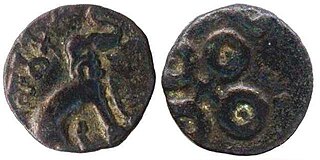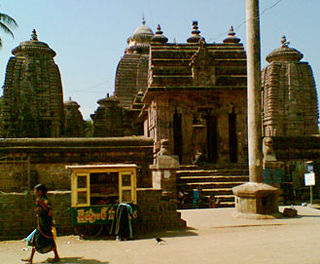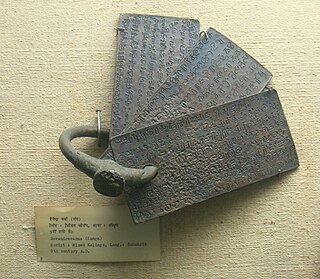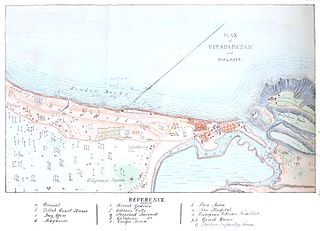Related Research Articles
Kalinga is a historical region of India. It is generally defined as the eastern coastal region between the Mahanadi and the Godavari rivers, although its boundaries have fluctuated with the territory of its rulers. The core territory of Kalinga now encompasses a large part of Odisha and northerneastern part of Andhra Pradesh. At its widest extent, the Kalinga region also included parts of present-day southwestern West Bengal and Chhattisgarh.

Chakravarti Kulottunga Choladeva was an 11th-century monarch of the Chola Empire of South India. He was one of the sovereigns who bore the title "Kulottunga", literally meaning "the exalter of his race" in Tamil. He did not belong to the main line of Cholas but was rather a prince of the Eastern Chalukya dynasty. His mother, Ammangaidevi, was a Chola princess and the daughter of emperor Rajendra Chola I. His father was king Rajaraja Narendra of the Eastern Chalukya dynasty who was the nephew of Rajendra Chola I and maternal grandson of Rajaraja Chola I. According to historian Sailendra Nath Sen, his accession marked the beginning of a new era and ushered in a period of internal peace and benevolent administration.
The Kalinga War was fought in ancient India between the Maurya Empire under Ashoka and the state of Kalinga, an independent feudal kingdom located on the east coast, in the present-day state of Odisha and northern parts of Andhra Pradesh. It is presumed that the battle was fought on Dhauli hills in Dhauli which is situated on the banks of Daya River. The Kalinga War was one of the largest and deadliest battles in Indian history. Kalinga did not have a king as it was culturally run without one.

Asmaka or Assaka (Pali) was a Mahajanapada in ancient India which existed between 700 BCE and 425 or 345 BCE according to the Buddhist texts Anguttara Nikaya and Puranas. It was located around and between the Godavari river in present-day Telangana and Maharashtra. Its capital is variously called Potali or Podana, and is identified as present-day Bodhan in Telangana.

Telugu people, also rendered as Telugus, are one of the four major and the largest Dravidian ethnolinguistic group in terms of population native to the Indian states of Andhra Pradesh, Telangana and the Yanam district of Puducherry. A significant number of Telugus also reside in the surrounding Indian states of Karnataka, Tamil Nadu, Maharashtra, Gujarat, West Bengal,Chhattisgarh, Kerala and Odisha, as well in the union territory of Andaman and Nicobar Islands. The Telugus, like some other South Asians, are largely descended from a varied mixture of Pre-Dravidian tribes, Dravidian and Indo-Aryan people. The group earliest associated with the Telugu identity were the Andhras, a tribe from whom the Telugus inherit their ethnonym, who were known to have migrated from the banks of River Yamuna in the North to the banks of Krishna and Godavari in the South-East of the Subcontinent right in the Telugu-heartland postulated to be of Indo-Aryan in speech and culture.
Kharavela was a Yadava king of Kalinga in present-day Odisha, India, who ruled during the second or first century BCE. The primary source for Kharavela is his rock-cut Hathigumpha inscription. The inscription is undated, only four of its 17 lines are completely legible, others unclear, variously interpreted and disputed by scholars. The inscription written with Jainism-related phrases recites a year by year record of his reign and panegyrically credits him with public infrastructure projects, welfare activities, patronage of the arts, and many military victories. Although it exaggerates his achievements, historians agree that it is best and most complete biography of Kharavela available. He is believed to have been a follower of Jainism, although the Hathigumpha inscription describes him as a devotee of all religions and scholars find the violence and wars he led difficult to reconcile with the Ahimsa value in Jainism.

The Hathigumpha Inscription is a seventeen line inscription in Prakrit language incised in Brahmi script in a cavern called Hathigumpha in Udayagiri hills, near Bhubaneswar in Odisha, India. Dated between 2nd-century BCE and 1st-century CE, it was inscribed by the Jain king Kharavela of Kalinga kingdom.
The Bruhat Palayanas were an ancient Indian dynasty based in the modern state of Andhra Pradesh. They ruled Northern Andhra with Pithunda, near Machilipatnam as the capital after the Ikshvakus around the third century. Jaya Varma was the only known Bruhatpalayana ruler. A princess of his family was married to the Andhra Ikshvaku king. His Kingdom included Musala Taluk as far as Gudivada, Kolleru and northern parts of Guntur. He gave the village of Patur in Tenali Taluk to eight Brahmins. After his death the Ananda Gotrikas occupied his territory to the south of the Krishna river and the Salankayanas took his territory north of the river.

Satakarni was the third of the Satavahana kings, who ruled the Deccan region of India. His reign is generally dated to 70-60 BCE, although some authors have claimed 187-177 BCE, and most recently dated to 88-42 BCE. It was thought there were "two Satakarnis", however, Andrew Ollett argues that there is only one Satakarni, as the alleged first Satakarni is assigned ten years, and the second, fifty years by other scholars, but the only dated inscription of this king is Candankheda seal from his reign's year 30, around 60 BCE, and he ruled ca. 88-42 BCE.

Anakapalle is a suburb of Visakhapatnam in the Indian state of Andhra Pradesh. The municipality was merged with Greater Visakhapatnam Municipal Corporation. It has the second largest jaggery market of the country.

The name Odisha refers to the current state in India. In different areas the region and parts of the region were known by different names. The boundaries of the region also have varied over time.

Uttarandhra is a region consisting of three north coastal districts of the Indian state of Andhra Pradesh. It comprises the districts of Srikakulam, Vizianagaram and Visakhapatnam. As of 2011 census of India, the region with three districts has a population of 9,338,177.

The recorded history of Andhra Pradesh, one of the 28 states of 21st-century India, begins in the Vedic period. It is mentioned in Sanskrit epics such as the Aitareya Brahmana. Its sixth-century BCE incarnation Assaka lay between the Godavari and Krishna Rivers, one of sixteen mahajanapadas. The Satavahanas succeeded them, built Amaravati, and reached a zenith under Gautamiputra Satakarni.

The Kalinga script or Southern Nagari is a Brahmic script used in the region of what is now modern-day Odisha, India and was primarily used to write Odia language in the inscriptions of the kingdom of Kalinga which was under the reign of early Eastern Ganga dynasty. By the 12th century, with the defeat of the Somavamshi dynasty by the Eastern Ganga monarch Anantavarman Chodaganga and the subsequent reunification of the Trikalinga(the three regions of ancient Odra- Kalinga, Utkala and Dakshina Koshala) region, the Kalinga script got replaced by the Siddhaṃ script-derived Gaudi or Proto-Oriya script which became the ancestor of the modern Odia script.

The Eastern Ganga dynasty also known as Rudhi Gangas or Prachya Gangas were a large medieval era Indian royal dynasty that reigned from Kalinga from as early as the 5th century to the early 15th century. The territory ruled by the dynasty consisted of the whole of the modern-day Indian state of Odisha as well as major parts of West Bengal, Andhra Pradesh and Chhattisgarh. The early rulers of the dynasty ruled from Dantapuram; the capital was later moved to Kalinganagara, and ultimately to Kataka . Today, they are most remembered as the builders of the world renowned Puri Jagannath Temple and Konark Sun Temple, a UNESCO World Heritage Site at Konark, Odisha.

The Mahameghavahana dynasty was an ancient ruling dynasty of Kalinga after the decline of the Maurya Empire. In the first century B.C., Mahameghavahana, a king of Chedirastra conquered Kalinga and Kosala. During the reign of Kharavela, the third king of Mahameghavahana dynasty, South Kosala became an integral part of the kingdom. He patronised Jainism, but did not discriminate against other religions. He is known by his Hathigumpha inscription.

The Maritime history of Odisha, known as Kalinga in ancient times, started much before 800 BC according to early sources. The people of this region of eastern India along the coast of the Bay of Bengal sailed up and down the Indian coast, and travelled to Indo China and throughout Maritime Southeast Asia, introducing elements of their culture to the people with whom they traded. The 6th century Manjusrimulakalpa mentions the Bay of Bengal as Kalingodra and in ancient Classical India, the Bay of Bengal was known as Kalinga Sagar, indicating the importance of Kalinga in the maritime trade. The old traditions are still celebrated in the annual Boita Bandana festival including its major celebration at Cuttack on the banks of Mahanadi river called Bali Jatra, and are held for seven days in October-November at various coastal districts, most famous at Cuttack though.
Sinhapura was the capital of the legendary Indian king Sinhabahu. It has been mentioned in the Buddhist legends about Prince Vijaya. The name is also transliterated as Sihapura or Singhapura.

Visakhapatnam is Metro City in the state of AndhraPradesh and also largest city in the state. Visakhapatnam history dates from 2500 years ago and the present name is given by Eastern Chalukyas king fo their Family deity Visakha in 1010 AD.
References
- 1 2 Ramesh Chandra Majumdar, Anant Sadashiv Altekar (1986). Vakataka - Gupta Age Circa 200-550 A.D. Motilal Banarsidass. p. 68. ISBN 81-208-0026-5.
- 1 2 Balabhadra Ghadai (July 2009). "Maritime Heritage of Orissa" (PDF). Orissa Review. Retrieved 2010-11-25.
- ↑ Romila Thapar (2004). Early India: From the Origins to AD 1300. University of California Press. p. 212. ISBN 0-520-24225-4.
- ↑ Nihar Ranjan Patnaik (1997). Economic history of Orissa. Indus Publishing. p. 131. ISBN 81-7387-075-6.